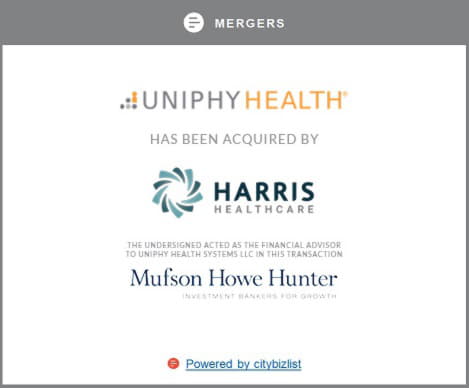NEW YORK--(BUSINESS WIRE)--Pfizer Inc. (NYSE:PFE) reported financial results for third-quarter 2018 and narrowed certain 2018 financial guidance ranges.
On February 3, 2017, Pfizer completed the sale of its global infusion therapy net assets, Hospira Infusion Systems (HIS). Therefore, financial results for the first nine months of 2018 do not reflect any contribution from legacy HIS operations, while the first nine months of 2017 reflect approximately one month of legacy HIS domestic operations and approximately two months of legacy HIS international operations(3).
Some amounts in this press release may not add due to rounding. All percentages have been calculated using unrounded amounts. References to operational variances pertain to period-over-period growth rates that exclude the impact of foreign exchange(4).
2018 FINANCIAL GUIDANCE(5)
Pfizer’s updated 2018 financial guidance is presented below.
The guidance range for Revenues was narrowed from a range of $53.0 to $55.0 billion to a range of $53.0 to $53.7 billion, primarily reflecting:
- lower-than-anticipated Essential Health revenues, primarily due to continued legacy Hospira Sterile Injectable Pharmaceuticals (SIP) product shortages in the U.S.; and
- recent unfavorable changes in foreign exchange rates in relation to the U.S. dollar from mid-July 2018 to mid-October 2018, primarily the weakening of certain emerging markets currencies and the euro.
Financial guidance for Adjusted diluted EPS(2) reflects anticipated share repurchases totaling approximately $12 billion in 2018, including $9.0 billion of share repurchases already completed to date in 2018. Dilution related to share-based employee compensation programs is expected to offset the reduction in shares associated with these share repurchases by approximately half.
CAPITAL ALLOCATION
- During the first nine months of 2018, Pfizer returned $13.2 billion directly to shareholders, through a combination of:
- $6.0 billion of dividends, composed of $0.34 per share of common stock in each of the first, second and third quarters of 2018; and
- $7.2 billion of share repurchases, composed of $3.2 billion of open-market share repurchases and a $4.0 billion accelerated share repurchase agreement executed in March 2018 and completed in September 2018.
- As of October 30, 2018, Pfizer’s remaining share repurchase authorization was $7.4 billion.
EXECUTIVE COMMENTARY
Ian Read, Chairman and Chief Executive Officer, stated, “We reported solid third-quarter 2018 financial results, with total company revenues up 2% operationally, driven by the continued growth of key brands such as Eliquis, Ibrance, Prevnar 13, Xeljanz and Xtandi, as well as biosimilars and emerging markets. The performance of these growth drivers was partially offset by product losses of exclusivity, a decline in Legacy Established Products in developed markets and ongoing legacy Hospira sterile injectable supply shortages.
“We believe we are well-positioned to develop and commercialize differentiated new medicines, creating sustainable value for shareholders and patients. Our new organizational structure allows us to focus on maximizing the opportunity of our in-market products, advancing key pipeline programs and accelerating growth in emerging markets.
“Earlier this month, we announced that Albert Bourla will succeed me as CEO starting in January 2019. Albert’s extensive knowledge of our business, firm grasp of the issues, and deep caring for patients will help Pfizer continue to build on the outstanding foundation we have put in place. I am confident that he is implementing a structure and building a leadership team that will maximize the company’s growth opportunities,” Mr. Read concluded.
Frank D’Amelio, Executive Vice President, Business Operations and Chief Financial Officer, stated, “I am pleased with our results over the first nine months of 2018, which keep us on track to deliver a solid financial performance this year. We updated our 2018 financial guidance to reflect our performance to date as well as our outlook for the remainder of the year. Importantly, the midpoint of our guidance range for Adjusted diluted EPS(2), which implies 13% growth compared to last year, is unchanged from our July 2018 guidance update. Additionally, to date in 2018, we returned $15.0 billion directly to shareholders through dividends and share repurchases, demonstrating our continued commitment to returning capital to our shareholders.”
QUARTERLY FINANCIAL HIGHLIGHTS (Third-Quarter 2018 vs. Third-Quarter 2017)
Third-quarter 2018 revenues totaled $13.3 billion, an increase of $130 million, or 1%, compared to the prior-year quarter, reflecting operational growth of $243 million, or 2%, partially offset by the unfavorable impact of foreign exchange of $113 million, or 1%.
Innovative Health (IH) Highlights
- IH revenues increased 5% operationally, primarily driven by continued growth from key brands including:
- Eliquis globally, up 36% operationally, primarily driven by continued increased adoption in non-valvular atrial fibrillation as well as oral anti-coagulant market share gains;
- Ibrance outside the U.S., up 98% operationally, primarily driven by continued uptake in developed Europe and the December 2017 launch in Japan;
- Prevnar 13 in the U.S., up 12%, primarily due to higher government purchases for the pediatric indication;
- Xeljanz globally, up 26% operationally, primarily driven by continued uptake in the rheumatoid arthritis indication; and
- Xtandi in the U.S., up 20%, primarily due to continued uptake in the metastatic castrate-resistant prostate cancer (CRPC) indication,
partially offset primarily by:
- the loss of exclusivity of Viagra in the U.S. in December 2017 and the resulting shift in the reporting of Viagra revenues in the U.S. and Canada to the Essential Health business at the beginning of 2018(3); and
- lower revenues for Enbrel in most developed Europe markets primarily due to continued biosimilar competition.
Essential Health (EH) Highlights
- EH revenues declined 4% operationally, negatively impacted primarily by:
- a 14% operational decline in the Legacy Established Products (LEP) portfolio in developed markets, primarily driven by industry-wide pricing challenges in the U.S. and generic competition;
- a 17% operational decline in the Peri-LOE Products portfolio in developed markets, primarily due to expected declines in Lyrica in developed Europe, partially offset by the addition of Viagra revenues from the U.S. and Canada that were previously recorded in the IH business; and
- a 9% operational decline in the SIP portfolio in developed markets, primarily due to continued legacy Hospira product shortages in the U.S.,
partially offset primarily by:
- 11% operational growth in emerging markets, primarily reflecting growth across the LEP and SIP portfolios in China; and
- 46% operational growth from Biosimilars in developed markets, primarily from Inflectra in certain channels in the U.S. as well as in developed Europe.
Pfizer recorded other income––net(1) in third-quarter 2018 compared with other deductions––net(1) in the prior-year quarter, primarily due to:
- a non-cash gain associated with a transaction with Bain Capital Private Equity and Bain Capital Life Sciences to create a new biopharmaceutical company, Cerevel Therapeutics, LLC, to continue development of a portfolio of clinical and preclinical stage neuroscience assets primarily targeting disorders of the central nervous system;
- lower charges for certain legal matters; and
- lower asset impairment charges.
Pfizer’s effective tax rate on Reported income(1) for third-quarter 2018 was favorably impacted by:
- the adoption of a territorial tax system and the lower U.S. tax rate as a result of the December 2017 enactment of the TCJA(6), as well as favorable adjustments to the provisional estimate of the legislation;
- the favorable change in the jurisdictional mix of earnings as a result of operating fluctuations in the normal course of business; and
- an increase in benefits associated with the resolution of certain tax positions pertaining to prior years primarily with various foreign tax authorities, and the expiration of certain statutes of limitations.
Pfizer’s effective tax rate on Adjusted income(2) for third-quarter 2018 was favorably impacted by the aforementioned December 2017 enactment of the TCJA(6).
Third-quarter 2018 diluted weighted-average shares outstanding used to calculate Reported(1) and Adjusted(2) diluted EPS declined by 54 million shares compared to the prior-year quarter primarily due to Pfizer’s ongoing share repurchase program, reflecting the impact of share repurchases during 2018, partially offset by dilution related to share-based employee compensation programs.
A full reconciliation of Reported(1) to Adjusted(2) financial measures and associated footnotes can be found starting on page 22 of the press release located at the hyperlink below.
RECENT NOTABLE DEVELOPMENTS (Since July 31, 2018)
Product Developments
- Ibrance (palbociclib) -- In October 2018, Pfizer announced detailed overall survival (OS) data from the PALOMA-3 trial, which evaluated Ibrance in combination with fulvestrant compared to placebo plus fulvestrant in women with hormone receptor-positive (HR+), human epidermal growth factor receptor 2-negative (HER2-) metastatic breast cancer whose disease progressed on or after prior endocrine therapy. In the study, there was a numerical improvement in OS of nearly seven months with Ibrance plus fulvestrant compared to placebo plus fulvestrant (median OS: 34.9 months [95% CI: 28.8, 40.0] versus 28.0 months [95% CI: 23.6, 34.6]), although this difference did not reach the pre-specified threshold for statistical significance (HR=0.814; 95% CI: 0.644, 1.029; 1-sided p=0.0429). These data were presented as a late-breaking oral abstract during the Presidential Symposium at the 2018 Congress of the European Society for Medical Oncology and simultaneously published in The New England Journal of Medicine (NEJM). The difference in OS demonstrated in this analysis (6.9 months) is consistent with the improvement previously demonstrated for the primary endpoint of progression-free survival (PFS) in PALOMA-3. In the updated, non-pre-specified PFS analysis, the combination of Ibrance plus fulvestrant showed a statistically significant and clinically meaningful 6.6-month PFS improvement compared to placebo plus fulvestrant (11.2 vs. 4.6 months; HR=0.50 [95% CI, 0.40-0.62]; P<0.0001).
- Lyrica (pregabalin) -- In August 2018, Pfizer completed its submission to the U.S. Food and Drug Administration (FDA) seeking pediatric exclusivity for Lyrica. Pfizer anticipates a decision from the FDA by December 30, 2018, the current anticipated loss of market exclusivity date. If granted, pediatric exclusivity would extend the period of U.S. market exclusivity for Lyrica by an additional six months, to June 30, 2019.
- Talzenna (talazoparib) -- In October 2018, Pfizer announced that the FDA approved Talzenna, a once-daily, oral poly ADP ribose polymerase inhibitor for the treatment of adult patients with deleterious or suspected deleterious germline BRCA-mutated, HER2- locally advanced or metastatic breast cancer. Patients are selected for therapy based on an FDA-approved companion diagnostic.
- Vizimpro (dacomitinib) -- In September 2018, Pfizer announced that the FDA approved Vizimpro, a kinase inhibitor for the first-line treatment of patients with metastatic non-small cell lung cancer with epidermal growth factor receptor exon 19 deletion or exon 21 L858R substitution mutations as detected by an FDA-approved test.
- Vyndaqel (tafamidis)
- In September 2018, Pfizer announced that additional sensitivity and post-hoc analyses from the Phase 3 Transthyretin Amyloid Cardiomyopathy (ATTR-ACT) study provide further detail on the effect of tafamidis across wild-type, hereditary, and New York Heart Association (NYHA) class sub-groups of patients with transthyretin amyloid cardiomyopathy (ATTR-CM). Tafamidis reduced the risk of all-cause mortality across all sub-groups (wild-type, hereditary and NYHA I, II and III functional class) versus placebo. This included a 29% and 31% reduction in the risk of death observed in wild-type (HR 0.71; 95% CI [0.474, 1.052]) and hereditary (HR 0.69; 95% CI [0.408,1.167]) sub-groups, respectively. The findings were presented during the Heart Failure Society of America Annual Scientific Meeting.
- In August 2018, Pfizer announced the primary results from the ATTR-ACT study, which showed tafamidis significantly reduced the hierarchical combination of both all-cause mortality and frequency of cardiovascular-related hospitalizations compared to placebo over a 30-month period (P=0.0006) in patients with wild-type or variant (hereditary) ATTR-CM. The ATTR-ACT study showed tafamidis significantly reduced all-cause mortality (29.5% vs. 42.9%; hazard ratio = 0.70, 95% confidence interval [CI] 0.51-0.96, P=0.0259) and cardiovascular-related hospitalizations (0.48 vs 0.70 annualized rate; relative risk ratio = 0.68, 95% CI 0.56-0.81, P<0.0001), compared to placebo. This represents a 30% reduction in the risk of mortality and 32% reduction in the rate of cardiovascular-related hospitalization. The late-breaking findings were presented during the European Society of Cardiology Congress 2018 and simultaneously published online in NEJM. The NEJM manuscript, titled “Tafamidis Treatment for Patients with Transthyretin Amyloid Cardiomyopathy,” was also published in the September 13 printed issue of NEJM.
- Xeljanz (tofacitinib) -- In August 2018, Pfizer announced that the European Commission (EC) approved Xeljanz 10 mg twice-daily (BID) for at least eight weeks, followed by Xeljanz 5 mg BID or 10 mg BID, for the treatment of adult patients with moderately to severely active ulcerative colitis (UC) who have had an inadequate response, lost response, or were intolerant to either conventional therapy or a biologic agent. Xeljanz is the first and only oral therapy and Janus kinase (JAK) inhibitor to be approved for this patient population. In approving Xeljanz for UC, the European Medicines Agency’s Committee for Human Medicinal Products has, as part of its assessment, determined Xeljanz to be of significant clinical benefit for patients with UC in comparison with existing therapies.
- Xtandi (enzalutamide)
- In October 2018, the EC approved Xtandi for the treatment of adult men with high-risk non-metastatic CRPC. Xtandi was previously approved by the EC for the treatment of adult men with metastatic CRPC.
- In August 2018, Pfizer and Astellas announced amendments to the protocols for two registrational Phase 3 trials, ARCHES and EMBARK, designed to evaluate the safety and efficacy of Xtandi in men with hormone-sensitive prostate cancer. These amendments accelerate timelines for the anticipated primary completion dates of both trials. Changes to the ARCHES protocol include revision of the planned analyses of the primary and secondary endpoints. Enrollment was completed earlier this year. The companies now anticipate the primary completion date for the ARCHES clinical trial to be in late 2018. The previously expected primary completion date was April 2020. The main purpose of the amendment to the EMBARK protocol is to revise the planned analyses of the primary and several secondary endpoints, which reduced the target sample size. Enrollment was completed earlier this year. With these changes, the estimated primary completion date for the EMBARK clinical trial is mid-2020. Previously, the expected primary completion date for EMBARK was March 2021.
Pipeline Developments
A comprehensive update of Pfizer’s development pipeline was published today and is now available at www.pfizer.com/science/drug-product-pipeline. It includes an overview of Pfizer’s research and a list of compounds in development with targeted indication and phase of development, as well as mechanism of action for some candidates in Phase 1 and all candidates from Phase 2 through registration.
- Domagrozumab (PF-06252616) -- In August 2018, Pfizer announced that it is terminating two ongoing clinical studies evaluating domagrozumab for the treatment of Duchenne muscular dystrophy (DMD): a Phase 2 safety and efficacy study (B5161002) and an open-label extension study (B5161004). The Phase 2 study (B5161002) did not meet its primary efficacy endpoint, which was to demonstrate a difference in the mean change from baseline in 4 Stair Climb (in seconds) following one year of treatment with domagrozumab as compared to placebo in patients with DMD. Further evaluation of the totality of evidence including secondary endpoints did not support a significant treatment effect. The decision comes after a thorough review of data available at the time of the primary analysis, which evaluated all study participants after one year of treatment, as well as those participants who were in the trial beyond one year. The studies were not terminated for safety reasons. Pfizer will continue to review the data to better understand any insights they may provide, and will share results with the scientific and patient community.
- PF-05280014 (proposed biosimilar trastuzumab) -- In October 2018, the FDA acknowledged for review a Biologics License Application (BLA) resubmission for PF-05280014, a proposed biosimilar to Herceptin(7). This resubmission addressed information requested by the FDA in an April 2018 Complete Response Letter. The expected Biosimilar User Fee Act (BsUFA) goal date for a decision by the FDA is in first-quarter 2019. In July 2018, Pfizer announced that the EC approved Trazimera, the brand name for PF-05280014 in Europe.
- PF-05280586 (proposed biosimilar rituximab) -- In September 2018, the FDA accepted for review a BLA for PF-05280586, a proposed biosimilar to Rituxan/MabThera(8). The BsUFA goal date for a decision by the FDA is in third-quarter 2019.
- PF-06439535 (proposed biosimilar bevacizumab) -- In August 2018, the FDA accepted for review a BLA for PF-06439535, a proposed biosimilar to Avastin(9). The BsUFA goal date for a decision by the FDA is in second-quarter 2019.
- PF-06482077 -- In September 2018, Pfizer announced that its 20-Valent Pneumococcal Conjugate Vaccine (20vPnC) candidate, PF-06482077, received Breakthrough Therapy designation from the FDA for the prevention of invasive disease and pneumonia caused by Streptococcus pneumoniae serotypes in the vaccine in adults aged 18 years and older. Pfizer expects to start Phase 3 trials in a few months.
- PF-06651600
- In September 2018, Pfizer announced results from its Phase 2a study of PF-06651600, an oral JAK3 inhibitor, and PF-06700841, a tyrosine kinase (TYK) 2/JAK1 inhibitor, compared to placebo, in patients with moderate to severe alopecia areata (AA), an autoimmune disease characterized by hair loss and often associated with profound psychological consequences. Both JAK inhibitors met the primary efficacy endpoint in improving hair regrowth on the scalp relative to baseline at week 24 (33.6 points and 49.5 points for JAK3 and TYK2/JAK1, respectively) as measured by the Severity of Alopecia Tool score (100 point scale). The findings were presented during a Late-Breaking News session at the European Academy of Dermatology and Venereology Congress. Based on the totality of the data and the emerging clinical profiles, Pfizer decided to advance PF-06651600 to the next phase of development for moderate to severe AA and will continue to be evaluated for rheumatoid arthritis, Crohn’s disease (CD) and UC. PF-06700841 will continue to be evaluated for psoriasis, CD and UC.
- In September 2018, Pfizer announced PF-06651600 received Breakthrough Therapy designation from the FDA for the treatment of patients with AA.
- Tanezumab (PF-4383119, RN624) -- In October 2018, Pfizer and Eli Lilly and Company (Lilly) presented results from a Phase 3 study evaluating the efficacy and safety of subcutaneous administration of tanezumab, an investigational humanized monoclonal antibody, in patients with osteoarthritis (OA) pain treated for 16 weeks. The study met all three co-primary efficacy endpoints, demonstrating that among patients with moderate-to-severe OA pain of the knee or hip, both dosing regimens of tanezumab were associated with a statistically significant improvement in pain, physical function and patient’s global assessment of their OA, compared to placebo.
The Phase 3 OA study evaluated changes from baseline to 16 weeks for three co-primary efficacy endpoints of pain intensity and physical function, assessed using the Western Ontario and McMaster Universities Osteoarthritis Index subscale and patient’s overall assessment of their OA. At 16 weeks of treatment, patients receiving tanezumab reported significantly greater pain relief compared to those taking placebo, with more than half of patients reporting a reduction in their pain of 50% or more, and approximately 35% reporting a 70% or greater improvement.
Tanezumab was generally well tolerated, with 0.4% and 1.3% of patients in the tanezumab 2.5 mg and 2.5/5 mg arms, respectively, discontinuing treatment due to adverse events (AEs); 1.3% of patients in the placebo arm discontinued treatment due to AEs. No cases of osteonecrosis were observed in the study. Rapidly progressive osteoarthritis (RPOA) was observed with tanezumab-treated patients at a frequency of 1.3% and was not observed in the placebo arm. The incidence of RPOA Type 1 (accelerated joint space narrowing) in the tanezumab 2.5 mg and 2.5/5 mg arms was 1.3% and 0.4%, respectively, and the incidence of RPOA Type 2 (damage or deterioration of the joint) was 0.9% and 0%, respectively. In the study, 3.5% and 6.9% of patients receiving tanezumab 2.5 mg and 2.5/5 mg, respectively, had total joint replacement surgery, compared to 1.7% receiving placebo. The majority of surgeries (68%) took place after treatment was completed, during or shortly after the 24-week safety follow up period of the study. All surgeries in this study took place among patients with more severe OA at screening (Kellgren-Lawrence grade 3-4). These data were presented during a late-breaking oral session at the 2018 American College of Rheumatology Annual Meeting.
Corporate Developments
- In October 2018, Pfizer announced that it entered into a non-exclusive clinical development agreement with Novartis to investigate one or more combination therapies for the treatment of non-alcoholic steatohepatitis (NASH). The companies will conduct both non-clinical and Phase 1 clinical studies of Pfizer’s investigational therapies, including an Acetyl CoA-Carboxylase inhibitor (PF-05221304, currently in Phase 2), a Diacylglycerol O-Acyltransferase 2 inhibitor (PF-06865571, Phase 1) and a Ketohexokinase inhibitor (PF-06835919, Phase 2), together with Novartis’s tropifexor, a non-bile acid, Farnesoid X receptor agonist. With three assets in development and several first-in-class pre-clinical candidates under investigation, Pfizer is building a robust NASH program, which was entirely developed in-house and targets NASH through multiple, diverse pathways of the disease. The collaboration with Novartis helps Pfizer to explore combination approaches at an early stage.
- In October 2018, Bain Capital, LP and Pfizer announced the creation of Cerevel Therapeutics, LLC (Cerevel), a new biopharmaceutical company focused on developing drug candidates to treat disorders of the central nervous system (CNS). Pfizer is contributing a portfolio of pre-commercial neuroscience assets to Cerevel, which include three clinical-stage compounds and several pre-clinical compounds designed to target a broad range of CNS disorders including Parkinson’s, Alzheimer’s, epilepsy, schizophrenia and addiction. Funds affiliated with Bain Capital Private Equity and Bain Capital Life Sciences have committed $350 million with the ability to provide additional capital should it be needed in the future. Bain Capital and Pfizer will support Cerevel in building a dedicated team of CNS scientists and life sciences executives with extensive experience in clinical development of potential therapies for patients who have neurological and neuropsychological diseases. The most advanced assets in the portfolio are a D1 partial agonist which will likely enter Phase 3 in 2019 to treat the symptoms of Parkinson’s disease, and a Phase 2 ready selective GABA 2/3 agonist which will initially be studied for epilepsy. The company also has active programs in early development, discovery and a research program in neuroinflammation. Pfizer felt that placing this set of neuroscience assets, after its decision to curtail research within the area, in a company with dedicated focus and expertise in CNS was the optimal next step. Pfizer will retain a 25% equity position in Cerevel. Two senior Pfizer executives, Morris Birnbaum, MD, PhD, Senior Vice President, Chief Scientific Officer of Internal Medicine, and Doug Giordano, Senior Vice President of Worldwide Business Development will serve on the Cerevel Board of Directors, along with Adam Koppel and Chris Gordon, Managing Directors of Bain Capital. The company will be based in the Greater Boston area.
- In October 2018, Pfizer announced its Board of Directors unanimously elected Dr. Albert Bourla, Pfizer Chief Operating Officer, to succeed Ian Read as CEO effective January 1, 2019. Ian Read will transition from his current role as Chairman and CEO to Executive Chairman of Pfizer’s Board of Directors.
The executive team that will report to Dr. Bourla, coincident with the commencement of his new role, will be as follows:
- Frank D’Amelio – Chief Financial Officer and Executive Vice President, Global Supply and Business Operations, will also assume the leadership for our manufacturing operations, Pfizer Global Supply.
- Mikael Dolsten – Global President, Worldwide Research and Development and Medical, will also assume oversight of the Chief Medical Officer’s role.
- Michael Goettler – Global President, Established Medicines. As previously announced, Michael will lead the Established Medicines business that will operate as an autonomous, stand-alone unit within Pfizer.
- Angela Hwang – Group President, Pfizer Innovative Medicines, will become the Group President of Pfizer’s science-based Innovative business responsible for the entire portfolio of innovative medicines.
- Rady Johnson – Executive Vice President, Chief Compliance, Quality and Risk Officer, will continue in his role as the company’s Chief Compliance Officer.
- Doug Lankler – Executive Vice President, General Counsel, will continue in his role as the company’s General Counsel.
- Freda Lewis-Hall – Executive Vice President, Chief Patient Officer, will assume a new role as Pfizer’s Chief Patient Officer, deploying the resources of the company to advocate on behalf of all patients who rely on Pfizer to deliver new therapies and vaccines.
- Rod MacKenzie – Executive Vice President, Chief Development Officer, will expand his responsibilities to include Pfizer’s regulatory affairs function in addition to all late stage development activities.
- Dawn Rogers – Executive Vice President, Chief Human Resources Officer, will continue to lead the Human Resources team.
- Sally Susman – Executive Vice President, Chief Corporate Affairs Officer, will continue to lead the Corporate Affairs function.
- John Young – Group President, Chief Business Officer, will assume a new role, responsible for strategy, business development, portfolio management and valuation activities; business analytics; global commercial operations; and Patient and Health Impact, among others. Pfizer’s Consumer Healthcare business will also report to John.
Additionally, given the growing strategic importance of deploying digital technologies in research, discovery and business processes, Pfizer is appointing a Chief Digital Officer responsible for creating and implementing a strategy that accelerates and improves our digital capabilities so we can deliver more value to patients. Lidia Fonseca will join Pfizer’s Executive Leadership Team in January 2019, as Executive Vice President, Chief Digital and Technology Officer.
Please find Pfizer’s press release and associated financial tables, including reconciliations of certain GAAP reported to non-GAAP adjusted information, at the following hyperlink:









